The MSI MEG X570 Godlike Motherboard Review: Thor's Flagship
by Gavin Bonshor on August 28, 2019 12:00 PM EST- Posted in
- Motherboards
- AMD
- MSI
- 10G Ethernet
- Ryzen
- PCIe 4.0
- Ryzen 3000
- X570
- X570 Godlike
- MEG
Visual Inspection
The MSI MEG X570 Godlike is an E-ATX motherboard which combines a wide variety of highly premium controllers and wraps it up in a very elegant design. On the aesthetics, MSI has gone with an all-black PCB which is flanked by a black metal and plastic rear panel cover, as well as the X570 chipset heatsink which is actively cooled, but uses the Zero Frozr technology; this means that the fan has a semi-passive design which ramps up when it needs to keep the warm running X570 chipset cool.
Along the bottom of the board is an overclocker's toolkit which consists of a reset button, power button, and an MSI Game Boost dial which allows users to select from seven different overclocking presets. Also located along the bottom are two little buttons which allow users to increase or decrease the base clock on the fly in steps of a single MHz; this is more for extreme overclockers looking to squeeze every last MHz of performance out of memory and CPU. Other headers around the edge of the board include two USB 3.1 G2 headers (four ports), one front panel USB 3.1 G2 Type-C port, two USB 2.0 headers (four ports), and a front panel audio header. The MSI MEG X570 Godlike has a total of nine 4-pin fan headers which are split into three main areas; one for the CPU fan, one for a water pump, and seven for chassis fans. There are also two 2-pin thermal sensor connectors and a 3-pin water flow connector meaning this model is very suitable for enthusiasts looking for a top of the range model to use with a custom water cooling loop.
Dominating the lower portion of the MSI MEG X570 Godlike's PCB is four full-length PCIe 4.0 slots which operate at x16, x8/x0/x8, x8/x4/x4, and x8/x4, with the bottom full-length slot running at PCIe 4.0 x4. Sandwiched in between the full-length slots are three PCIe 4.0 x4 M.2 slots each with its own individual Lightning Gen4 M.2 heat shield. MSI also includes six SATA ports, and due to MSI bundling the X570 Godlike with an M.2 Xpander-Z Gen4 add-on card using its Frozr cooler, we also get an additional two PCIe 4.0 x4 M.2 drives.
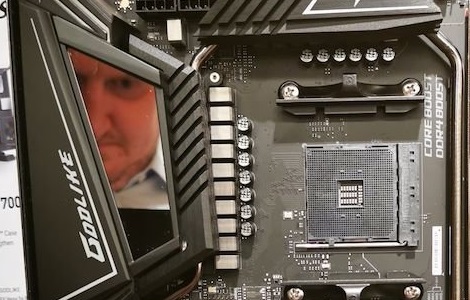
Me looking all angry and Godlike at Computex 2019 (Image credit to Coreteks)
On the rear panel cover is MSI's Infinity Mirror II panel which allows users to create funky RGB LED effects, something MSI has used before on previous models such as the MSI MEG Z390 Ace. This along with the 4-pin ARGB header, two 3-pin RAINBOW RGB headers and single 3-pin Corsair RGB LED header can be customized within the Mystic Light section of the MSI Dragon Center software.
Over on the right-hand side is four memory slots which support up to DDR4-4800 and up to 128 GB which is impressive in itself is the Dynamic Dashboard which allows users to view the board's vital statistics including various states of system status, and more impressively, allows users to upload their own animated GIF. This is made from OLED and its controls can be accessed from the MSI Dragon Center within the Mystic Light RGB utility.
Designed to push the 16 core CPU even higher, power deliveries for X570 have had to be upgraded over the previous X370 and X470 chipsets. The MSI MEG X570 Godlike is a primary example of this and runs a 14-phase power delivery for the VCore, and a 4-phase setup for the VGT/SoC. The PWM controller of choice is the International Rectifier IR35201 which is operating in 7+1 mode, with 14 x TDA21472 70 A power stages running with 7 x IR3599 doublers. On the SoC, it's slightly different with 4 x TDA21472 70 A power stages, but with a single IR3599 doubler which looks to be splitting the PWM signal into four. Providing power to the CPU is two 8-pin 12 V ATX CPU power inputs.
The VGT/SoC could have easily have been designed with just two phases, but there's an element of marketing strategy with vendors that more means better, which isn't always the case. Cooling the power delivery is a large and robust aluminium heatsink which is interconnected via a heat pipe to the actively cooled X570 chipset heatsink.
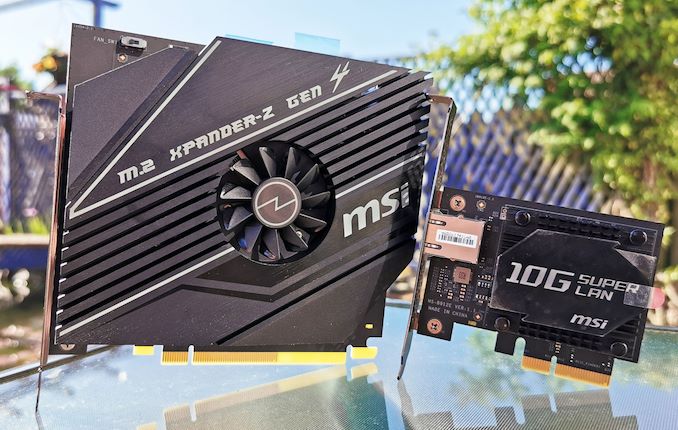
M.2 Xpander-Z Gen4 with two M.2 slots (left), Aquantia AQC107 10 G LAN Addon Card (right)
Another interesting inclusion is a dedicated 10 G Aquantia AQC107 NIC add-on card which gives users the choice to use either 10 G or use the integrated Killer E3000 2.5G and Killer E2600 Gigabit Ethernet ports located on the rear panel. Also featured is the Killer AX1650 Wi-Fi 6 802.11ax wireless interface which also includes support for BT 5.0 devices. This enables other features, such as offering the system using the Wi-Fi interface as an access point.
As it currently stands, the MSI MEG X570 Godlike is the only model to feature two Realtek ALC1220 HD audio codecs. One powers the rear panel audio connectors, while the second is for the front panel audio connector. Supplementing these is twelve gold Japanese audio capacitors, as well as four WIMA audio capacitors around the ESS E9018 Sabre DAC which drives the 6.3mm stereo headphone output on the rear panel. MSI has also included a physical layer of audio PCB separation to reduce electrical interference.
Looking closer at the rear panel of the X570 Godlike, there are three USB 3.1 Gen2 Type-A, one USB 3.1 G2 Type-C, and two USB 3.1 G1 Type-A ports. Commonly featured on premium models, the MSI MEG X570 Godlike also has a pre-installed rear panel IO shield. Also present is a Flash BIOS button with a highlighted Type-A port dedicated to firmware flashing, as well as a Clear CMOS button, and a PS/2 combo port. The onboard audio is high-end as in addition to the Realtek ALC1220 HD audio codecs which drive the five 3.5 mm jacks and S/PDIF optical output, MSI has included an ESS E9018 DAC for good measure, which also powers the dedicated 6.3 mm jack for studio headphones for audiophiles. The rear panel has two Ethernet ports with a Killer pairing consisting of an E3000 2.5 G, and E2600 Gigabit NIC, with a Killer AX1650 powering this model's Wi-Fi 6 802.11ax wireless capabilities.
What's in the Box
One of the aspects that makes the MSI MEG X570 Godlike such a premium product is the accessories bundle accompanying it. We've already touched on the M.2 Xpander-Z Gen4 add-on card which allows users to add an extra two M.2 drives to the three PCIe 4.0 M.2 slots onboard, and the additional Aquantia AQC107 10G Super LAN NIC, but there's more. Also included inside the box are six red and black braided SATA cables, a number of RGB extension cables, an antenna set for the integrated Killer AX1650 Wi-Fi 6 wireless interface, a 6.3 mm audio adapter, a user manual, with an additional quick installation guide also included for good measure.
- 6 x Red and black braided SATA cables
- RGB LED Y 80 cm extension cable
- Corsair RGB LED 50 cm extension cable
- Rainbow RGB LED 80 cm extension cable
- Corsair to Rainbow RGB 10 cm extension cable
- 2 x Thermistor cables
- Killer AX1650 antenna set
- M.2 Xpander-Z Gen4 M.2 add-on card
- 10 G Super LAN add-on card
- 3 x M.2 installation screws
- 6.3 mm audio adapter
- Case badge
- SATA cable label sheet
- Product registration card
- Driver installation disk
- User manual
- Quick Guide
- Quick installation guide


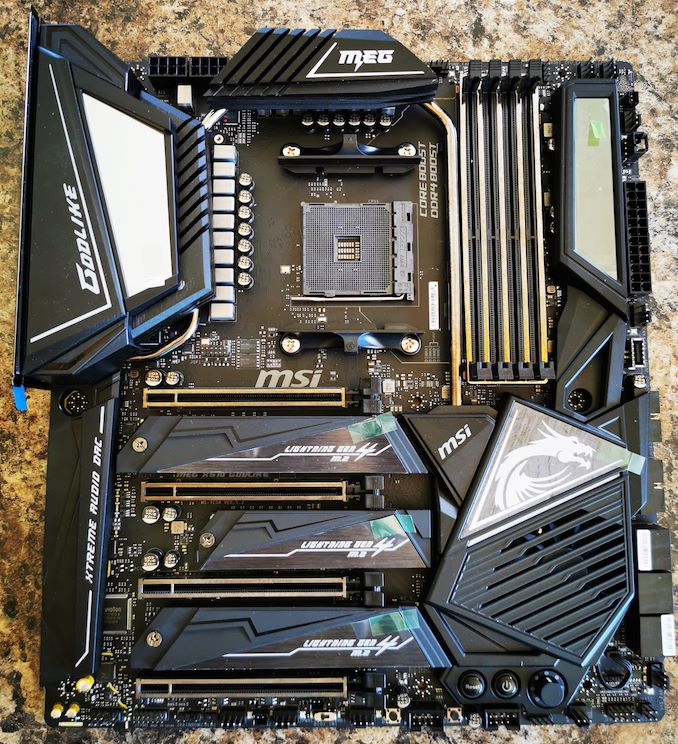
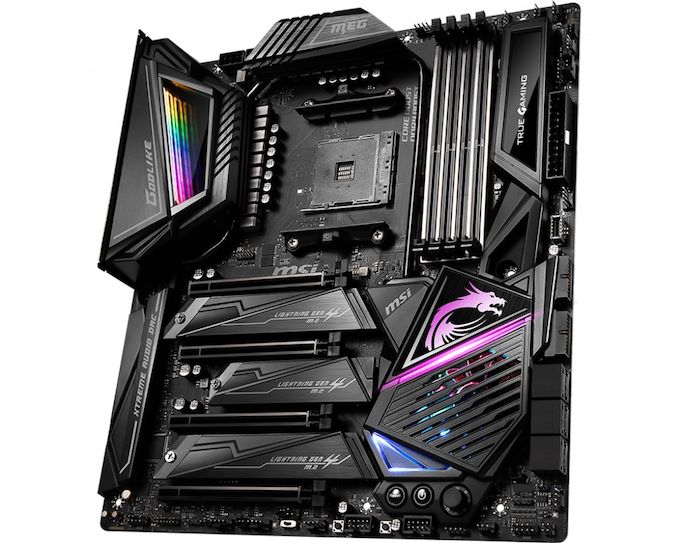
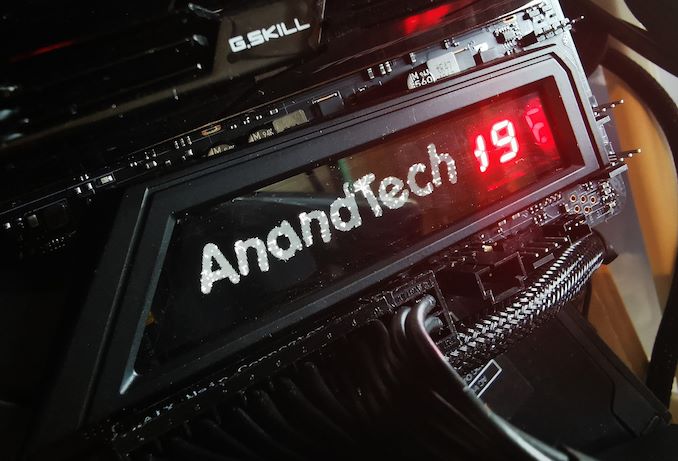

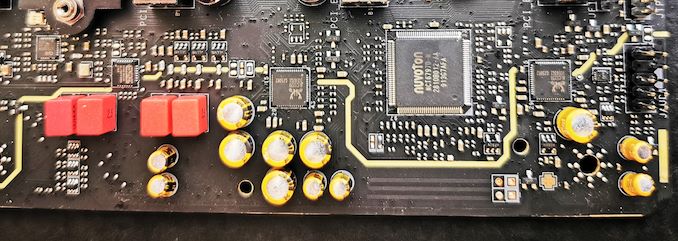

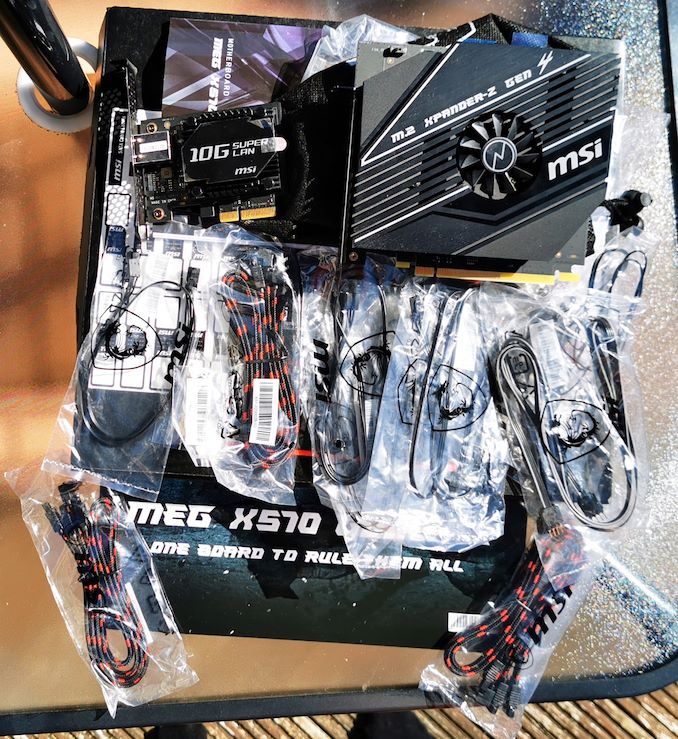








116 Comments
View All Comments
inighthawki - Saturday, August 31, 2019 - link
If your monitor cannot display more than 75hz, then having a framerate about 75hz cannot make it any smoother. The display will scan out one image every 13.3ms, no more, no less. However, rendering above 75hz can make it feel more *responsive* because the image being scanned out can be more recent. This is due to the reduced latency. Perhaps you are confusing the two concepts? Otherwise if it appears smoother it could just be the game itself causing enough single frame stuttering (while maintaining and average greater than 75) that makes things less noticeable at higher framerates.>> but as you mentioned.. could be cause of the games i play, dont need it.. i assume, then, you play a lot of 1st person shooters ?
Yes I do. Other games are not as noticeable - many I can play perfectly fine at 60fps without an issue. However fast paced games like Overwatch are very difficult for me at anything under 144. My goal is to also switch to the 240hz panels once the 1440p panels are available.
Peter2k - Thursday, August 29, 2019 - link
Just because 1 in a million gamers would play at 720p at all, especially after forking over major cash, does not mean its a realistic scenarioinighthawki - Thursday, August 29, 2019 - link
My point wasn't that his scenario was realistic. He's suggesting that the only time this would be an issue (i.e when the CPU would be a bottleneck) is if you bought a mediocre CPU and spent a ton on the GPU, to which I said, is not true. Many games benefit heavily from single threaded performance on even the highest end CPUs when you're trying to hit very high framerates.It's great if the people here like to play at 4K ultra settings and get 60fps but there are a lot of people who prefer framerate over quality. Hitting 144hz or 240hz on the lowest settings in many titles is quite taxing on the CPU.
Qasar - Friday, August 30, 2019 - link
" Many games benefit heavily from single threaded performance on even the highest end CPUs " and that performance, is tied to the cpu's IPC, so the frequency a cpu can get.. isnt the be all tell all of performance. " but there are a lot of people who prefer framerate over quality " and there are also a lot of people that prefer quality over frame rate, point is ?inighthawki - Friday, August 30, 2019 - link
Performance is based on IPC and frequency, not just IPC. A CPU that already has a higher base IPC *and* can overclocking the frequency much more has a huge advantage in single threaded performance scenarios.>> and there are also a lot of people that prefer quality over frame rate, point is ?
I never said those people are wrong. I've been being told throughout this discussion that my decisions are stupid or wrong because it's what I care about. If people prefer the quality then more power to them, I'm happy they're getting what they want.
Qasar - Friday, August 30, 2019 - link
" A CPU that already has a higher base IPC *and* can overclocking the frequency much more has a huge advantage in single threaded performance scenarios. " then explain why Zen 2, while clocked 600 mhz slower is with in a few % of the intel equivalent. which is because Zen does more instructions per clock, then intel does at the moment. again.. the frequency a cpu can get, isnt the tell all, be all when it comes to performance.. look at the P4 and A64 days.if Zen 2 were to clock higher, then its quite possible, the performance would be in amds favor across the board.
inighthawki - Saturday, August 31, 2019 - link
Youre misunderstanding what I'm saying. I didn't say "greater frequency == greater performance". You should go back and re-read my posts.Qasar - Saturday, August 31, 2019 - link
thats how it sounds, cause thats how you seem to have worded it.. to get higher IPC, the freq the cpu runs at, also has to go up.. but thats not necessarily the case, and with Zen2, it does more work per clock, compared to intel, which is is while clocked slower, the performance is close enough, its not worth the extra cash that intel charges, in the case of the 9900K vs 3800X the price difference is a $150 difference, personally, id rather save that 150, and put it towards a better vid card, or something else, or get the 3900X for the same price as the 9900k. its also probably a safe bet, that if Zen 2 could reach the same clocks as the intel equivalent, then the question is, based on performance and price, why buy an intel cpuinighthawki - Saturday, August 31, 2019 - link
>> the performance is close enough, its not worth the extra cash that intel chargesAnd that's where we seem to disagree. The performance is not close enough. If we were talking a completely negligible give and take scenarios of 1-2fps that would be one thing. But many gaming benchmarks show the 9900K still having a 5 if not 10% upper hand in gaming scenarios. When my goal is hitting 144 or even 240fps in games, that is definitely not performance I'm willing to let go.
I'm not calling Zen2 a bad CPU lineup. The 3900X is a fantastic chip and meets the requirements of many people. Just not me. I don't need core count, I need maximum single threaded performance. I don't care about the dollar per clock per watt or anything like that.
Qasar - Saturday, August 31, 2019 - link
yep, then thats where we disagree... but that 5 or 10%. IMO.. isnt worth the price of the 9900K cause just the cpu alone is 150 bucks.. AND you NEED a mid high to high end cooler for that 9900K to reach those clocks, and sustain them add another $75 + to that, if the $200 premium is important to you, then by all means.. for me.. no thanks..